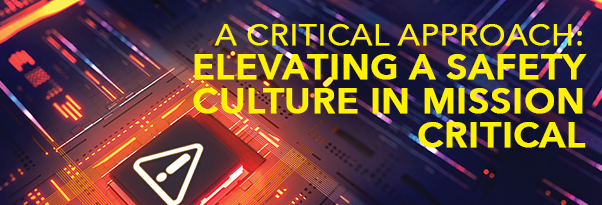
By Desmond Clark
Safety is the top priority on every jobsite, but the challenge now is how to not only improve upon it, but also to instill it into the culture and get buy-in from every single person who walks onto the project site. It requires trying different approaches and a commitment to a safety-first mindset—one that goes beyond the jobsite and extends to overall care. JE Dunn’s mission critical team recognizes that safety is more than an EMR score or other statistic; it’s a culture shift and holistic approach that acknowledges emotional and mental health are large parts of overall health and safety. Employed on mission critical jobsites in recent years, the JE Dunn teams are seeing results with a shift in approach, technology, and claims management.
KEEPING A FINGER ON THE PULSE
Deployed as a pilot program a few years ago, fatigue-monitoring wearables provided valuable insights and data aimed at driving safety decisions on a daily basis. While widespread deployment of the program is still being reviewed, the insights gleaned extended beyond those project teams and contributed to the evolution of JE Dunn’s comprehensive safety program for mission critical. A key indicator the wearables identified was sleep quality in addition to quantity. The scores, though, were telling a deeper story and pointed toward other factors that could be explored and addressed to improve overall safety—including mental health. Leadership took that information and used it to expand JE Dunn’s safety program on all mission critical sites to rethink resources, training, etc., to then implement a more holistic approach. One of the first things we did was send out non-biased perception surveys to keep our finger on the pulse to pinpoint gaps in safety and where we could do better as a team. We wanted honest feedback about how our teams and trade partners felt regarding their relationships with the owner, whether they felt valued, etc., which helped us identify more ways to get our workforce in front of the owner to bridge that gap while showcasing their expertise. We also asked about teams’ well-being, and what we found was that many people had high anxiety and worried about job security, health, and their families, among other things.
Because of these perception survey results, we researched mental health experts in construction to bring mental health sessions to our jobsites where a clinical psychologist talked about topics ranging from suicide within the construction industry to personal struggles. “The biggest thing we wanted to establish was that JE Dunn is a safe space, and that everyone’s voice will be heard,” said Vice President Chris Teddy. “Part of these sessions involved project management sitting in front of our craft workers and not only having open dialogue, but also showing vulnerability. The conversations were eye opening to everyone—owners included—and went a long way into leveling the playing field, so to speak, when it came to issues everyone is facing and ensuring everyone felt
valued.”
Improved mental health includes a clearer head for more attention to detail. The safety program also integrates technology to help direct focus should any mental slip-ups occur.
CLAIMS MANAGEMENT
Knowing that incidents are an unfortunate hazard that comes with construction, we took a proactive approach to mitigate lost-time incidents to head them off before they become problematic. “Often times, we see what an employee may deem as a minor injury not worthy of treatment snowball into a much larger, lost-time recordable if left unchecked or untreated,” said Teddy. “To head off those potential situations, we started providing on-call doctors at all mission critical jobsites. This gives our men and women the confidence of speaking to a trained doctor who can set them up with a work plan to better manage an injury before it results in lost time. Since employing this, we have more first-aid incidents rather than recordables, which benefits everyone. Last year, we used our virtual doctor a total of 61 times. Of those 61 times, only 10 became recordables, which kept the remaining 51 at a first-aid site level—a significant savings in cost.”
REAL-LIFE RESULTS
Looking at safety from a different, holistic angle was an approach not seen in mission critical construction—or much of the construction industry at all. The payoff? An industry-leading safety program for mission critical construction that permeates into the culture across the entire company. Some results are difficult to quantify, but the stories of the holistic training in action speak for themselves. “We had a situation where a foreman noticed something was not quite right with one of his workers, and because of the additional mental health safety resources and training, he pulled the worker aside and identified a deeper issue. The superintendent and foreman went above and beyond to support him and gave him the time he needed while ensuring he was secure in his job. Those types of things never happened before we included mental health as part of safety,” said Teddy. “We’ve had other general contractors reach out to ask what we are doing in our re-imagined, more comprehensive safety program, so while there’s more to learn and a number of ways to evolve, we know we are on the right track.”
Desmond Clark is Safety Manager at JE Dunn Construction. He can be reached at [email protected].